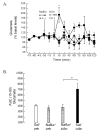Nalfurafine, the kappa opioid agonist, inhibits icilin-induced wet-dog shakes in rats and antagonizes glutamate release in the dorsal striatum
- PMID: 17150231
- PMCID: PMC1890045
- DOI: 10.1016/j.neuropharm.2006.10.010
Nalfurafine, the kappa opioid agonist, inhibits icilin-induced wet-dog shakes in rats and antagonizes glutamate release in the dorsal striatum
Abstract
Icilin, a cooling compound, produces vigorous wet-dog shakes in rats. We have reported previously that icilin-induced wet-dog shakes are blocked by the kappa opioid receptor agonists, nalfurafine and U50,488H, and that icilin evokes a dose- and time-dependent increase in glutamate within the dorsal striatum. Since activation of kappa opioid receptors inhibits glutamate release intrastriatally, we targeted glutamate release within the dorsal striatum using nalfurafine and examined the role of the dorsal striatum in icilin-induced wet-dog shakes, more specifically, the effect that icilin-evoked intrastriatal glutamate release has on the overt stimulant behavior. We report that nalfurafine (0.04mg/kg) inhibits icilin (0.50mg/kg)-induced wet-dog shakes and that this inhibition is reversed by intrastriatal perfusion of the kappa opioid receptor antagonist, norbinaltorphimine (100nM). Furthermore,we antagonized icilin-evoked glutamate release with nalfurafine (0.04mg/kg), and reversed inhibition of glutamate release with intrastriatal norbinaltorphimine (100nM). These findings support a central component in the behavioral response to icilin and suggest that activation of kappa opioid receptors antagonizes icilin-induced wet-dog shakes in rats by inhibiting glutamate release within the dorsal striatum.
Figures




Similar articles
-
Mu and kappa opioid receptor agonists antagonize icilin-induced wet-dog shaking in rats.Eur J Pharmacol. 2006 Oct 10;547(1-3):101-5. doi: 10.1016/j.ejphar.2006.07.026. Epub 2006 Jul 25. Eur J Pharmacol. 2006. PMID: 16945367
-
Icilin evokes a dose- and time-dependent increase in glutamate within the dorsal striatum of rats.Amino Acids. 2006 May;30(3):307-9. doi: 10.1007/s00726-005-0306-6. Epub 2006 Apr 20. Amino Acids. 2006. PMID: 16622598
-
Icilin-induced wet-dog shakes in rats are dependent on NMDA receptor activation and nitric oxide production.Pharmacol Biochem Behav. 2009 May;92(3):543-8. doi: 10.1016/j.pbb.2009.02.005. Epub 2009 Feb 25. Pharmacol Biochem Behav. 2009. PMID: 19248800
-
[Pharmacological effects of nalfurafine hydrochloride, a kappa-opioid receptor agonist].Nihon Shinkei Seishin Yakurigaku Zasshi. 2010 Nov;30(5-6):185-91. Nihon Shinkei Seishin Yakurigaku Zasshi. 2010. PMID: 21226314 Review. Japanese.
-
Nalfurafine hydrochloride: a new drug for the treatment of uremic pruritus in hemodialysis patients.Drugs Today (Barc). 2009 May;45(5):323-9. doi: 10.1358/dot.2009.45.5.1362067. Drugs Today (Barc). 2009. PMID: 19584962 Review.
Cited by
-
Icilin-evoked behavioral stimulation is attenuated by alpha₂-adrenoceptor activation.Brain Res. 2011 Apr 12;1384:110-7. doi: 10.1016/j.brainres.2011.02.002. Brain Res. 2011. PMID: 21315691 Free PMC article.
-
TRP channels and analgesia.Life Sci. 2013 Mar 19;92(8-9):415-24. doi: 10.1016/j.lfs.2012.08.010. Epub 2012 Aug 14. Life Sci. 2013. PMID: 22910182 Free PMC article. Review.
-
Effects of opioids, cannabinoids, and vanilloids on body temperature.Front Biosci (Schol Ed). 2011 Jun 1;3(3):822-45. doi: 10.2741/190. Front Biosci (Schol Ed). 2011. PMID: 21622235 Free PMC article. Review.
-
Dose-dependent effects of icilin on thermal preference in the hindpaw and face of rats.J Pain. 2009 Jun;10(6):646-53. doi: 10.1016/j.jpain.2009.01.002. Epub 2009 May 5. J Pain. 2009. PMID: 19409862 Free PMC article.
-
ThermoTRP channels in nociceptors: taking a lead from capsaicin receptor TRPV1.Curr Neuropharmacol. 2008 Mar;6(1):21-38. doi: 10.2174/157015908783769680. Curr Neuropharmacol. 2008. PMID: 19305786 Free PMC article.
References
-
- Bandell M, Story GM, Hwang SW, Viswanath V, Eid SR, Petrus MJ, Earley TJ, Patapoutian A. Noxious cold ion channel TRPA1 is activated by pungent compounds and bradykinin. Neuron. 2004;41:849–857. - PubMed
-
- Blandini F, Nappi G, Tassorelli C, Martignoni E. Functional changes of the basal ganglia circuitry in Parkinson’s disease. Prog Neurobiol. 2000;62:63–88. - PubMed
-
- Burford RG, Chappel CI. Abstracts of the Fifth International Congress of Pharmacology. Vol. 33 IUPHAR; San Francisco: 1972. “Wet dog shake” induction in rats by a novel compound AG-3-5.
Publication types
MeSH terms
Substances
Grants and funding
LinkOut - more resources
Full Text Sources

